Double white dwarfs
Common-envelope
evolution
AM CVn stars
Ultra-compact X-ray
binaries
Black hole binaries
SN Ia progenitors
Surveys
Gravitational waves
LISA wiki (verification
binaries)
Publications
Preprints
My thesis
AM CVn stars
AM CVn stars are blue, variable objects. After the first was discovered in 1967, Bohdan Paczynski proposed that such a system might be a pair of white dwarfs in a very tight orbit. The theory of general relativity predicts that such a system would emit gravitational waves and loose angular momentum. This drives mass transfer from the lower-mass (bigger) white dwarf to its companion. Despite the loss of angular momentum, the redistribution of mass makes the binary orbit widen and thus the orbital period increasing. See for more information the review I wrote for the 2004 Cataclysmic variables and related objects meeting.
Formation of AM CVn systems
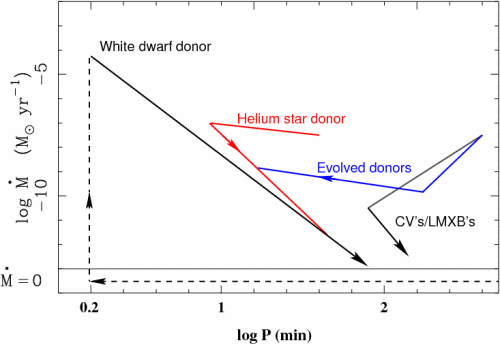
Three formation channels have been proposed (see above), one (black dashed plus solid, markes White dwarf donor) in which two white dwarfs spiral together due to Gravitational wave radiation (bottom dashed line), until the lowest one fills its Roche lobe and starts to transfer mass to the companion(vertical dashed line). The mass transfer pushes the system apart at decreasing mass transfer rate (solid line). Alternatively, the donor star can be a non-degenerate, helium core burning star that transfers mass to a white dwarf companion (red lines). The mass-transfer supresses the burning and is roughly constant while the binary evolves to shorter periods. At a period around 10 min the structure of the donor changes such that the period evolution is reversed and the system widens. Finally, the blue line shows the evolution of a system in which a main sequence star transfers mass to a white dwarf companion (Cataclysmic Variable, CV). When the mass transfer starts close to the end of core hydrogen burning, the system avoids the classical period minimum at about 80 min (solid black line) as the donor reaches its inner core, where most of the hydrogen is processed and thus evolves into a helium rich, compact object. For Ultra-compact X-ray binaries the formation channels are similar, except that the accreting star is a neutron star or black hole. The CV equivalent is then calles Low-mass X-ray binary (LMXB).
Galacitc population of AM CVn systems
Since the 1960s only a few handfuls of AM CVn systems have been discovered. In the meantime the theoretical models of how to bring two white dwarfs (or white dwarf like objects) in such close orbits have developed. The small number of known systems, however, makes it difficult to test the viability of the different models (see e.g. a paper I wrote about these models which is also Chapter 5 of my thesis)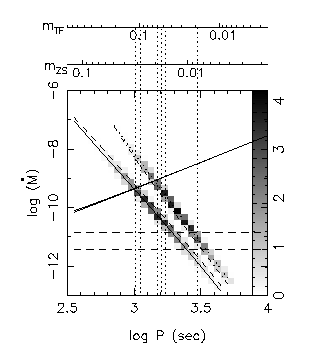
Model of the population of AM CVn systems with V magnitudes brighter than 15 as function of orbital period and mass transfer rate. Model II from Nelemans et al. 2001, A&A, 368, 939
Short period AM CVn systems
Of special interest are the shortest period AM CVn systems. They live very short, but have strong X-ray emission and might be in the so-called direct impact phase, in which the mass stream of the donor directly hits the accreting star (see for details Marsh, Nelemans & Steeghs (2004). They are also strong gravitational wave sources. We made a model for the Galactic population of these binaries, which is published in Nelemans et al. 2004.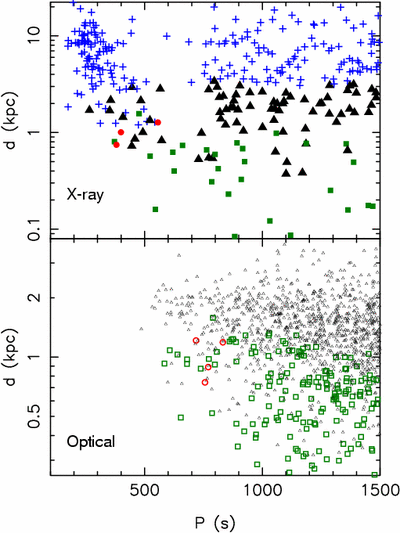
Short period AM CVn systems that can be observed as X-ray source (top panel, soft X-ray flux above 1e-13 erg/s/cm2) and as optical sources (bottom panel, V < 20) as function of orbital period and distance. Top: the blue plusses are systems only observable in X-rays, red circles: direct impact systems observable in X-ray and optical, green squares: systems detectable in X-ray with an optically visible donor and triangles: systems detectable in X-rays and with an optically visible disc. Bottom: red: direct impact systems, green squares: systems with a visible donore, triangles: systems with a visible accretion disc. From Nelemans et al. 2004.
Helium Novae and .Ia supernovae
The mass transfer rates onto the accreting white dwarfs are sufficiently high at early times (see figure at the top of the page), that the accumulating helium layer ignites and burns to carbon and oxygen in a bright flash which will make the helium layer expand. This will be observable as a helium nova. Because the mass transfer rate drops in time in AM CVn systems, and the accumulated mass becomes higher and higher for lower and lower accretion rates, there will inevitably be a "final flash". Below the expected mass in the layer for the final flash is shown as function of the mass of the accreting white dwarf (from Bildsten, Shen, Weinberg & Nelemans, 2007, ApJ, 662, 95 )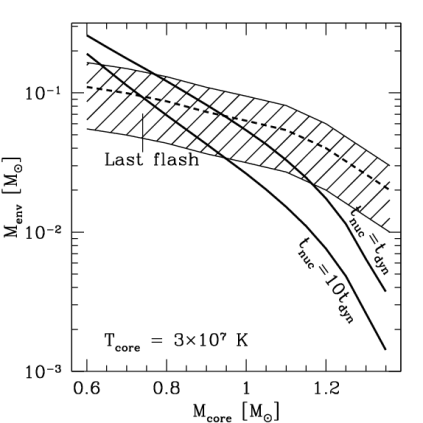
The exciting thing is that these masses are large enough that the ignited layer doesn't have time to expand and cool before the increasing temperature has caused nuclear reactions to form radioactive elements that through their decay power a supernova like explosion. These would show up as explosions similar to type Ia supernovae (explosions of a complete white dwarf), although less bright for a shorter time. Hence the suggested name .Ia (point Ia) supernovae. See Bildsten, Shen, Weinberg & Nelemans, 2007, ApJ, 662, 95 for more details.
Distinguising the donors by their abundance
The different formation channels that can lead to AM CVn stars can all lead to objects with similar periods and mass-transfer rates. Therefore, it has been difficult to determine which channels actually form the observed systems.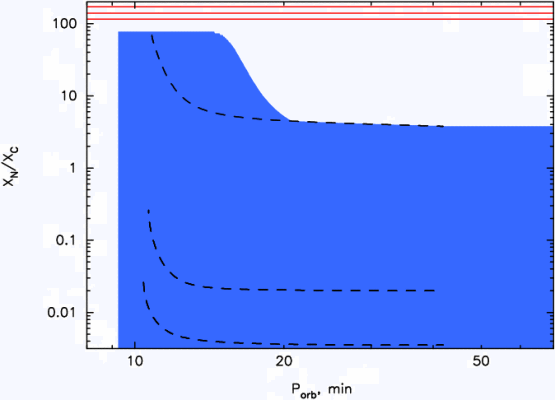
We studied the detailed chemical abundance of the material transferred from the donor star to the accreting white dwarf for the different formation channels and found that the N/C ratio is the best diagnostic, as helium white dwarf donors have high ratios (greater than 100), while helium star donors have ratios below about 80. Carbon-oxygen white dwarfs have no N at all, and remnants from evolved main-sequence donors typically still show some hydrogen. See Nelemans et al. 2009 for more details.
